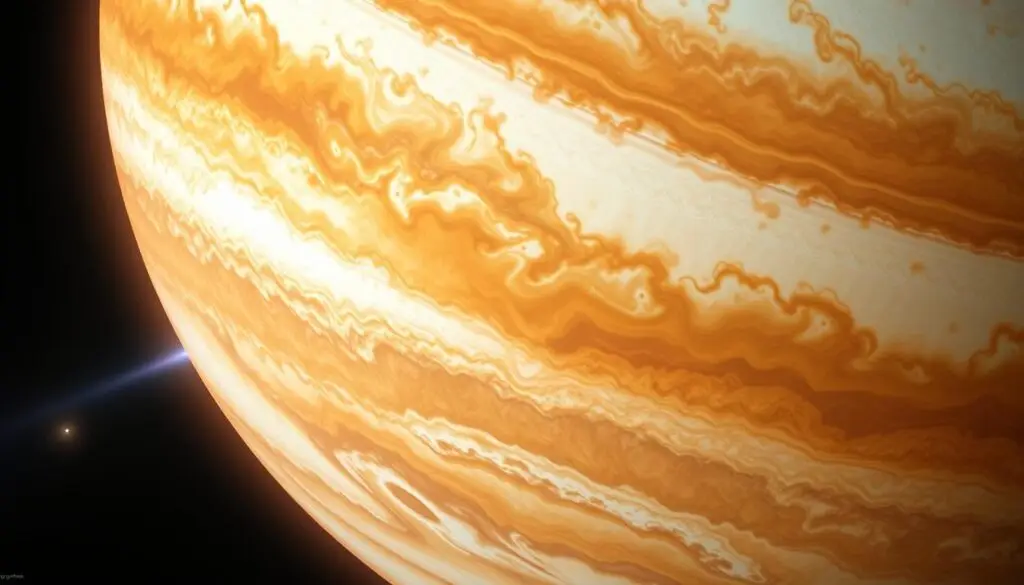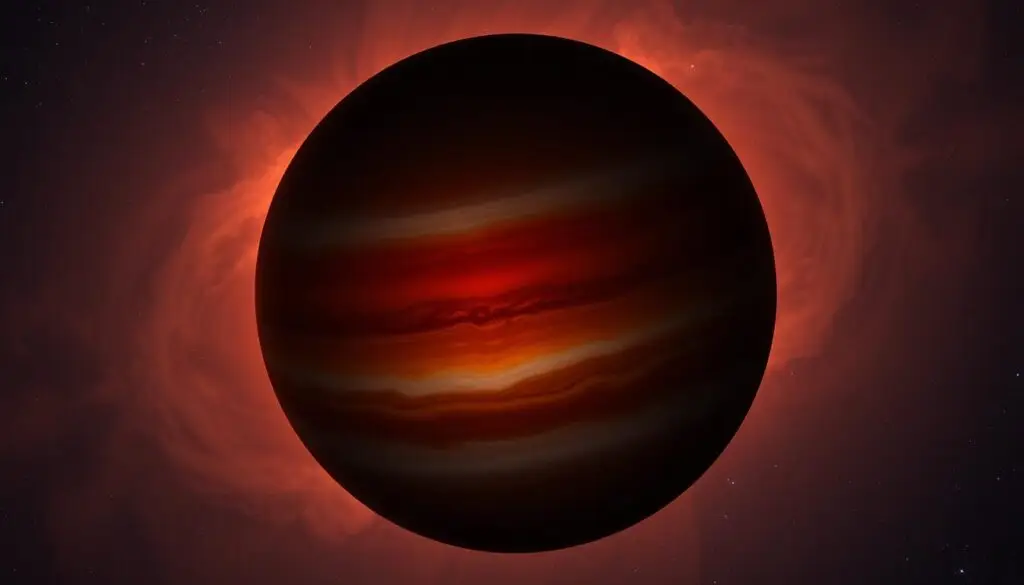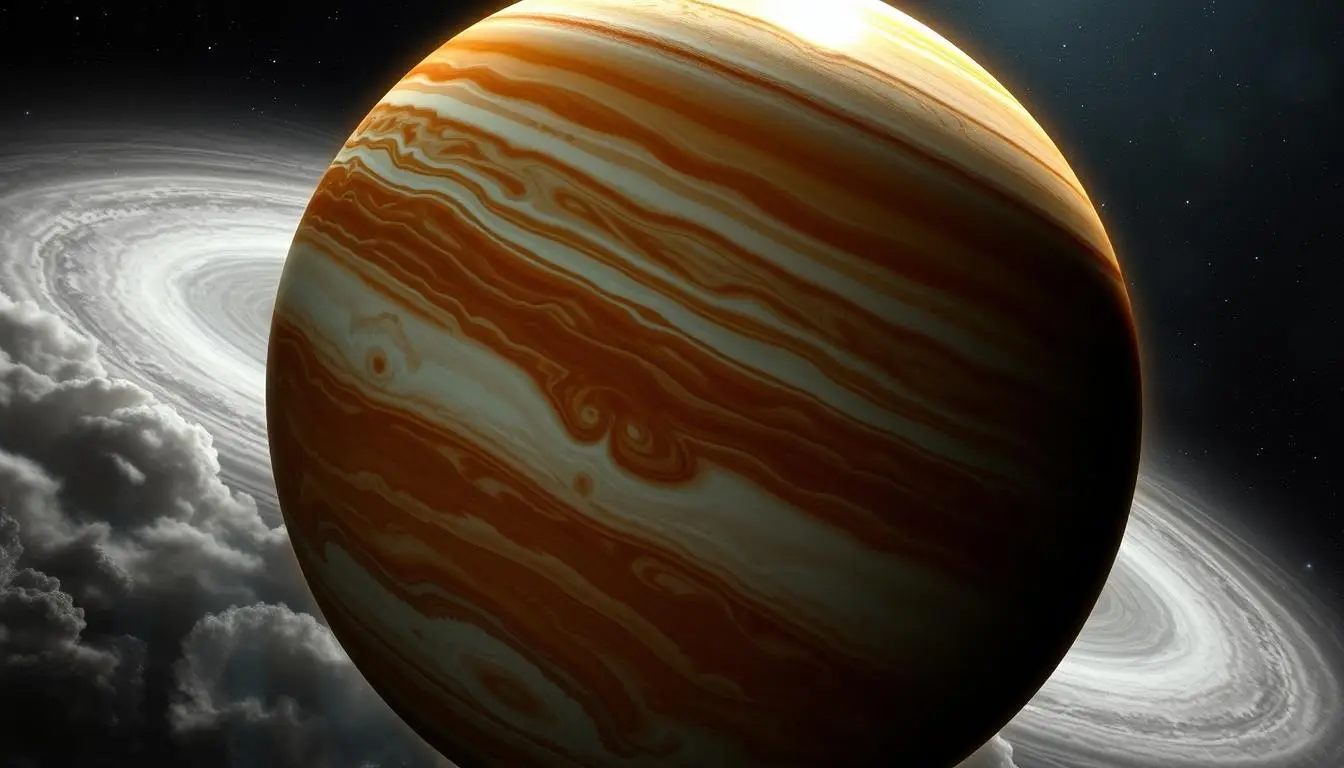Jupiter, the giant gas planet, is always amazing us. Its latest pictures show incredible swirling storms. These storms challenge what we know about weather on other planets. They are huge and have complex patterns, making Jupiter even more fascinating.
When Juno flies by Jupiter, it captures amazing images. It shows storms that are taller than 30 miles and wider than hundreds of miles. At Jupiter’s north pole, there’s a unique setup of storms. Eight cyclones circle a central one. The south pole is just as interesting with six cyclones that formed a hexagon, showing how Jupiter’s weather changes.
These discoveries are very important. Since 2011, the Juno mission has been revealing secrets about Jupiter’s weather. It zooms by the planet at 130,000 mph. These findings help us learn more about Jupiter. They also make us eager for future missions like the $2-billion Europa Clipper.
Key Takeaways
- Juno’s latest flyby captures stunning images of Jupiter’s swirling storms.
- Jupiter’s storms can be over 30 miles (50 kilometers) in height and hundreds of miles across.
- North pole reveals nine storms arranged with eight cyclones spinning counterclockwise around one central vortex.
- South pole exhibits cyclones forming intricate pentagon and hexagon patterns.
- The Juno mission continues to unravel the complexities and beauty of Jupiter’s atmosphere.
Introduction to Jupiter’s Swirling Storms
Jupiter, the giant gas planet, is famous for its stunning storm systems. The storms include Earth-sized vortices at its poles. Captured by NASA’s Juno mission, these storms offer a look into space exploration and atmospheric dynamics.
The Fascination of Jupiter’s Poles
The poles of Jupiter captivate scientists with their storm patterns. Covered in swirling storms, the poles reveal a dynamic atmosphere. The storms, large and packed closely, interact in a chaotic yet astonishing way. Studying these storms helps us understand planetary atmospheres and their importance in space exploration.
The Importance of Storm Studies
Studying Jupiter’s storms is key for scientists to learn about atmospheric dynamics and cloud chemistry. The Juno mission has been crucial since its 2011 launch. It reached Jupiter in 2016, unveiling the secrets of massive storms like the Great Red Spot.
This red spot is 10,000 miles wide and reaches 300 miles deep. These studies shed light on how giant planets form. They offer clues about Jupiter and other gas giants such as Saturn, Uranus, Neptune, and even exoplanets. Our understanding of space and distant planets grows through this research.
Juno’s Latest Flyby Jupiter Shows Amazing Swirling Storms
The Juno mission keeps showing us stunning views of Jupiter’s storms and atmosphere. On its 43rd close pass, called a perijove, the Juno spacecraft got amazing shots of Jupiter’s north pole. These images show us the storms and weather happening just 25,100 kilometers above Jupiter. The information we get helps us understand more about Jupiter’s weather.
Details of Juno’s 43rd Flyby
On its 43rd flyby, Juno sent back lots of high-quality images and data. It flew close enough to see the storms at Jupiter’s poles in detail. This data told us about the strength of the storms, how the clouds change, and where big cyclones are. This flyby is another big step in the mission that started when Juno got to Jupiter on July 5, 2016. Every flyby lets us see Jupiter’s atmosphere better.
New Insights into Jupiter’s Atmosphere
This recent flyby showed us new things about Jupiter’s atmosphere that we didn’t know before. It’s even more complex than we thought. Scientists are learning about how new cyclones form and how storms change. Understanding these things helps us learn more about weather systems on other planets too.
The JunoCam camera on Juno keeps taking amazing pictures of these changes. Citizen scientists help by working with these two-megapixel images. Juno is expected to do 42 more orbits by 2025. This will give us even more information about Jupiter’s storms and atmosphere.
Summary of Juno’s Mission and Key Flybys
| Event | Date | Details |
|---|---|---|
| Launch | 2011 | Juno launched by NASA to study Jupiter |
| Arrival at Jupiter | July 5, 2016 | Entered Jupiter’s polar orbit |
| Planned Mission End | October 2017 | Extended multiple times |
| Juno’s 43rd Flyby | Recent | Provided close-up images of north pole storms |
| Upcoming Perijove 67 | November 25, 2024 | Next scheduled flyby |
| Final Flyby | September 15, 2025 | Last planned perijove |
The Role of NASA’s Juno Mission
The NASA Juno mission has changed how we see Jupiter since its 2011 launch. From Cape Canaveral Air Force Station, it traveled 2.8 billion kilometers to Jupiter, arriving in orbit in 2016. Through its work, we’ve learned key facts about Jupiter’s make-up, magnetic fields, and weather patterns.
On its way, Juno got a speed boost from Earth in 2013. This help was crucial for it to reach Jupiter and start its research. Now, Juno moves in a special path that lets it fly closely over Jupiter’s clouds.
Juno’s data has taught us a lot. For instance, it found that Jupiter’s equator has more water than we thought, hinting at solar system secrets. This knowledge is vital for planetary science.
Juno’s unique orbit gives us a new view of Jupiter’s poles every 53 days. It has sent back thousands of pictures, showing us Jupiter’s storms and beautiful auroras.
Juno also explores Jupiter’s moons. It flew past Ganymede really fast, getting close to its surface. During this flyby, Juno studied Ganymede’s magnetic field and hidden ocean.
Here’s a quick look at Juno’s journey so far:
| Aspect | Details |
|---|---|
| Launch Date | August 5, 2011 |
| Jupiter Arrival | July 5, 2016 |
| Orbit Type | Highly Elliptical |
| Distance Traveled | 2.8 billion km |
| Gravity Assist Speed Boost | Over 14,000 km/h |
| Water in Atmosphere | 0.25% of molecules |
| Atmospheric Composition | 75% hydrogen, 24% helium |
| Wind Speed | Around 360 km/h |
| Power Source | Solar arrays with nearly 20,000 solar cells |
| Ganymede Flyby Speed | 40,000 miles per hour |
Juno’s mission, now going until 2025, will keep improving our understanding of Jupiter and its moons. This mission is making big contributions to planetary science.
Understanding Jupiter’s Atmosphere
Jupiter’s atmosphere captures scientists’ interest with its complex dynamic nature. Storms and changes happen fast here. Thanks to NASA’s Juno mission, we now have a close-up view of these rapid changes.
Atmospheric Dynamics
Jupiter’s atmospheric dynamics are complex yet fascinating. This gas giant is home to huge storms and diverse air movements. Juno’s images, taken from 15,379 miles up, show Jupiter’s poles. They’re filled with massive storms, similar in size to Earth, tightly packed and interacting intensely.
Understanding these atmospheric patterns is key. It helps predict Jupiter’s weather and improves our knowledge of atmospheric sciences.
Cloud Chemistry and Fluid Dynamics
Understanding Jupiter’s atmosphere means looking at its cloud chemistry and fluid dynamics. For example, there’s much more water in Jupiter’s atmosphere than in the sun’s. This reveals the chemical activities within the clouds.
Studying how fluids move and clouds form on Jupiter shows us the planet’s rapid changes. These insights are important for understanding the atmospheres of other worlds as well. They deepen our knowledge of atmospheric chemistry and fluid dynamics across the universe.
| Atmospheric Element | Details |
|---|---|
| Cloud Tops | Juno photos taken from 15,379 miles above |
| Water Content | 0.25% at equator – three times that of the Sun |
| Swirling Storms | Earth-sized storms densely clustered at poles |
The Giant Gas Planet: Jupiter
Jupiter is known as the giant gas planet. It is awe-inspiring and the largest in our solar system. Its size has helped us learn a lot about the solar system’s big planets. Thanks to missions like NASA’s Juno, we’re learning new, fascinating things about Jupiter.
To understand just how amazing Jupiter is, let’s look at its size and features:
| Attribute | Details |
|---|---|
| Number of Moons | 79 |
| Diameter | 88,846 miles (142,984 kilometers) |
| Great Red Spot Duration | Over 350 years |
| Orbital Period | 11.86 Earth years |
Jupiter’s huge gravity influences objects beyond it, keeping our solar system in order. The Juno mission shows how lively and dramatic Jupiter’s atmosphere is. A big storm, the Great Red Spot, keeps scientists fascinated as it spins without stopping.
Another wonder is the Great Blue Spot near Jupiter’s equator. This spot moves eastward, slowly circling Jupiter in 350 years. These events show how Jupiter’s atmosphere is always changing.
In 2024, the Europa Clipper mission will visit Jupiter’s moon, Europa. It will study Europa’s ocean beneath its surface. This may help us understand if other places can support life. Jupiter is central to space studies, pushing science forward.
With Juno, we got clear images of Jupiter’s storms. Sizes of these images vary greatly, with some as large as 6000x3000x3. These images reveal the complex storm systems and the beauty of Jupiter’s storms from afar.
In conclusion, Jupiter’s huge size and features make it very important for space studies. As the biggest planet, it is a big topic for astronomers and scientists. It helps us seek out the universe’s secrets.
Astronomical Discoveries from Juno
The Juno spacecraft has changed how we see Jupiter. It was launched on August 5, 2011. It started its journey to Jupiter on July 4, 2016. It has given us a lot of important data about Jupiter’s atmosphere, magnetic field, and moons.
Juno Spacecraft Data
Juno’s missions have been groundbreaking. On its first pass, it got really close to Jupiter, within about 2,600 miles of its clouds. Now, every 53 days, Juno flies over Jupiter’s north pole. This helps collect a lot of data, especially about Jupiter’s strong magnetic field.
Also, Juno’s Waves instrument recorded magnetic measurements that sound eerie when turned into audio. These discoveries have greatly added to our knowledge of planetary science.

Historical Discoveries and Recent Findings
Juno has taught us a lot about Jupiter and its moons. It has shown us how Jupiter’s big storms and atmosphere have changed over time. Juno’s close look at Ganymede, the biggest moon, has been very revealing. We learned more about its surface and the possible ocean under the icy crust. This helps us understand the Jovian system better.
| Aspect | Juno Discoveries |
|---|---|
| Magnetic Field | 10 times stronger than Earth’s (7.766 Gauss) |
| Close Flybys | Within 2,600 miles of Jupiter’s cloud tops and 645 miles of Ganymede’s surface |
| Mission Duration | Extended to September 2025 |
| Data Volume | 6 megabytes per transit, taking 1.5 days to download |
The data from Juno and the insights gained make a strong base for future space missions. The mission keeps helping our efforts to understand Jupiter’s mysteries.
Storm Patterns in Space
Space storms tell us a lot about weather on other planets. Jupiter is known for its huge storms. These are great for comparing with Earth’s weather. Studying these can help us understand how storms work, both here and far away.
Comparison with Earth’s Storms
Scientists study storms on both Earth and Jupiter. They want to understand weather better. The Juno mission showed us how Jupiter’s storms are different. It took an image size of 662x1125x3 on December 14, 2022. Jupiter’s storms are much bigger and stronger than Earth’s.
Unique Vortex Mechanics
Jupiter’s storms work differently from those on Earth. They have a unique pattern of cyclones. For instance, there are nine cyclones at Jupiter’s north pole and six at the south. This was shown by Juno’s image from June 22, 2023, with a size of 1644x2200x3. It shows how complex Jupiter’s weather is. This makes us want to study it even more.
| Comparison Feature | Earth’s Storms | Jupiter’s Storms |
|---|---|---|
| Size | Up to 1,000 miles in diameter | Thousands of miles in diameter |
| Wind Speed | Up to 200 miles per hour | Averages around 225 miles per hour |
| Duration | Days to weeks | Years to centuries (e.g., The Great Red Spot) |
| Visual Characteristics | Form distinct shapes, such as spirals | Complex, colored structures and multiple vortices |
| Number of Cyclones Observed | Limited and typically singular | Multiple (e.g., at least 9 in the north, 6 in the south) |
Comparing storms on Earth and Jupiter shows how different they are. Jupiter’s storms are much more complex. This is why we need to keep studying them. We can learn a lot about space weather this way.
The Great Red Spot of Jupiter
The Great Red Spot on Jupiter is a huge storm that’s bigger than Earth. It has caught the interest of scientists for years. Its bright colors and massive size make it key for studying planetary weather changes and Jupiter storm observation.
Historical Observations
People have watched the Great Red Spot for over 180 years. It might even have been seen in the 17th century. This storm helps us understand how weather on planets can last so long.
Astronomers keep an eye on its size, color, and how it moves. It’s one of the most closely watched things outside of Earth.
Current Dynamics
NASA’s Juno spacecraft has given us new info on the Great Red Spot. The Juno mission got to Jupiter in July 2016 after a long journey. It flew really close to the storm, just about 9,000 km away.
Now we know the storm is slowly getting smaller, with super strong winds. The JunoCam took amazing pictures from about 6,130 miles up. These show the storm’s complex weather.

Future Projections
Scientists are keeping an eye on how the Great Red Spot changes. They’re studying its ongoing shrinkage and Jupiter’s strong magnetic field. Jupiter’s field is way stronger than Earth’s.
Juno’s mission was adjusted due to engine problems, but it will keep studying Jupiter. We hope to learn even more from at least two more flybys of the Red Spot.
Impact of Juno’s Findings on Space Exploration
The Juno mission has greatly expanded our knowledge of Jupiter and the universe. It flew at 130,000 miles per hour over Jupiter’s Great Red Spot. This storm is the biggest in our solar system and spans 10,000 miles. Juno’s deep dive into Jupiter’s atmosphere revealed secrets of the planet’s deepest spots.
Thanks to Juno, we’ve learned a lot about Jupiter’s magnetic fields. These fields are more than 10 times as strong as Earth’s. This information helps us understand how giant planets form and study planets outside our solar system. Juno’s findings also help predict the future of the Great Red Spot and improve storm models.
Juno’s journey to Jupiter covered 1.74 billion miles and was a big leap in space exploration. Its orbit allowed it to see cyclones near Jupiter’s poles, which are up to 2,000 miles wide. Being just 2,600 miles above Jupiter’s clouds, Juno collected unique data.
Juno is notable for its advanced tools and huge solar arrays. These arrays work well even though Jupiter gets very little sunlight. The way Juno handled Jupiter’s harsh radiation shows how future space missions could be designed. It used strong materials to protect itself and its instruments.
In the end, Juno teaches us a lot not just about Jupiter, but about the formation of giant planets. It has shaped the goals for future missions to the outer planets. By studying Jupiter’s weather and gravity, Juno pushes us further into space exploration.
Citizen Scientist Contributions
Citizen science is crucial in today’s space exploration. It lets the public help with scientific discoveries. Through projects like NASA’s mission to Jupiter, thousands around the globe contribute. They process images and study Jupiter’s storms, helping us understand its atmosphere.
How to Get Involved
Getting involved in science is easier now. You can work with Juno’s images through online platforms. With JunoCam’s pictures, people get to explore Jupiter’s beauty. They also join in during Juno’s close approaches to Jupiter, processing data as it comes.
Impact of Public Data Processing
The role of the public in data processing is huge. They help handle the data from missions like Juno. This lets scientists analyze findings more deeply. The public’s work on Jupiter’s photos has provided new storm insights, adding to our knowledge.

